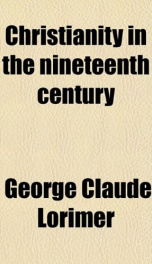christianity in the nineteenth century

Purchase of this book includes free trial access to www.million-books.com where you can read more than a million books for free. This is an OCR edition with typos. Excerpt from book: Ill THE MEDIEVAL AND MODERN Lead, kindly Light, amid the encircling gloom, Lead thou me on ; The night is dark, and I am far from home, Lead thou me on ; Keep thou my feet; I do not ask to see The distant scene ; one step enough for me. Nrwntan. THE RENAISSANCE OF MEDIEVAL ROMAN CATHOLICISM The original Renaissance marked, on its intellectual and literary side, the transition from that period of history known as the Middle Ages to that which is termed Modern. It consisted in a rebirth of the classical spirit and in a temporary burial of the poetry and legendary literature of the Middle Ages, such as " Barlaam and Josaphat," the "Nibelnngenlicd" the "Book of Heroes," and the " Holy Grail," and it revived a love of Greek art, as well as of Greek letters. The place of its nativity was within the charmed circle of the Roman Catholic world, whose power it undermined and toward whose disintegration it contributed. Unquestionably it facilitated and almost rendered inevitable the Reformation. According to Heine: Leo X., the magnificent Medici, was just as zealous a Protestant as Luther ; and as in Wittenberg protest was offered in Latin prose, so in Rome the protest was made in stone, colors, and ottava rhymes. For do not the vigorous marble statues of Michelangelo, Giulio Romano's laughing nymph faces, and the life-intoxicated merriment in the verses of Master Ludovico, offer a protesting contrast to the old, gloomy, withered Catholicism ? The painters of Italy combated priestdom more effectively, perhaps, than did the Saxon theologians.1 The Renaissance was thus, in a sense, the reawakening of paganism and its victory over the dominant typeof Christianity. It plainly announced that great Pan was not dead, and bound him in alliance with the mighty spiritu...
Info about the book
Author:
Series:
Unknown
ASIN:
052101042X
Rating:
4/5 (5)Your rating:
0/5
Languge:
English
Users who have this book
Users who want this book
What readers are saying
What do you think? Write your own comment on this book!
write a commentGenre
if you like christianity in the nineteenth century try:
Do you want to exchange books? It’s EASY!
Get registered and find other users who want to give their favourite books to good hands!


